Abstract
Partial trisomy of the long arm of chromosome 4, usually resulting from a familial segregation of a balanced translocation, has been described in a number of patients. This report describes the genetic and endocrine findings in a 16 year old 46,XY,12q+ mentally retarded male. The banding pattern of the extra chromatin material from this de novo unbalanced translocation shows that the distal segment of the long arm of chromosome 4 is involved. Comparison of the clinical features in this patient with cases of partial trisomy 4q previously reported support the cytogenetic evidence for this translocation involving the distal portion of 4q. Endocrine data suggested an end-organ resistance, characterised by extreme hyperinsulinaemia, primary hypothyroidism, and hypergonadotrophic hypogonadism associated with no signs of autoimmunity. To our knowledge, no endocrine evaluation has been previously reported in patients with partial trisomy 4q.
Full text
PDF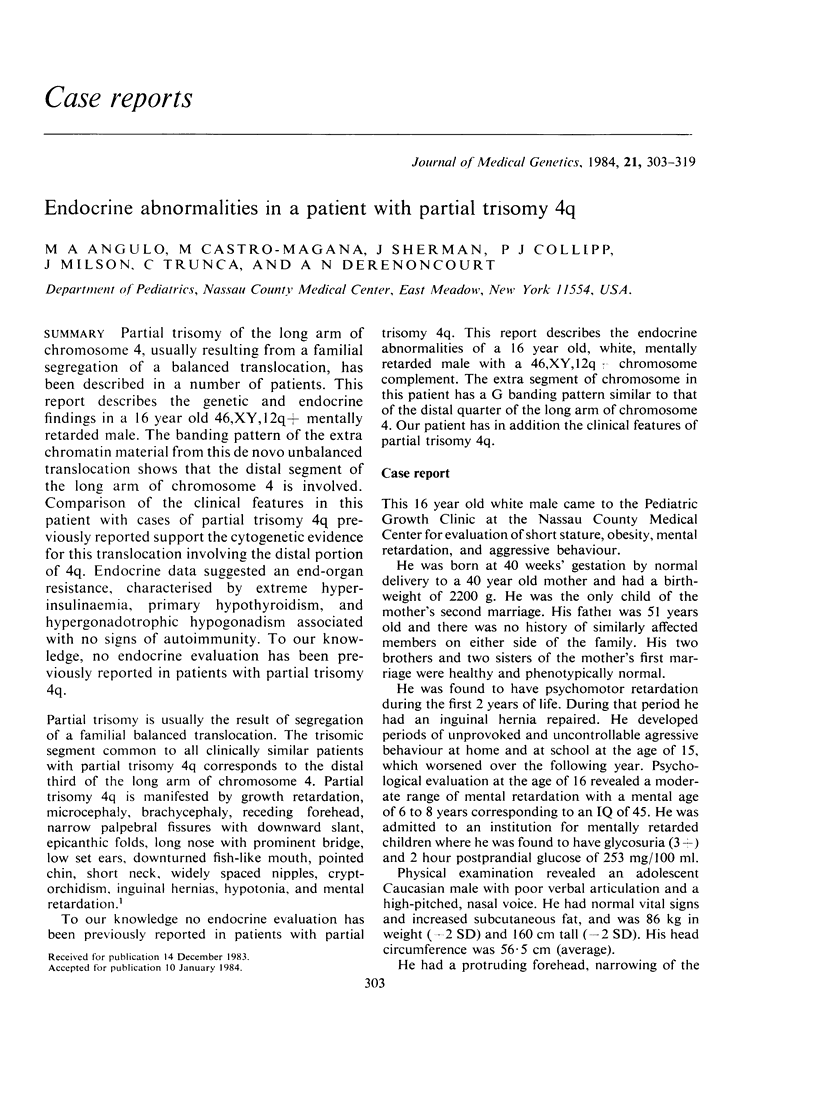
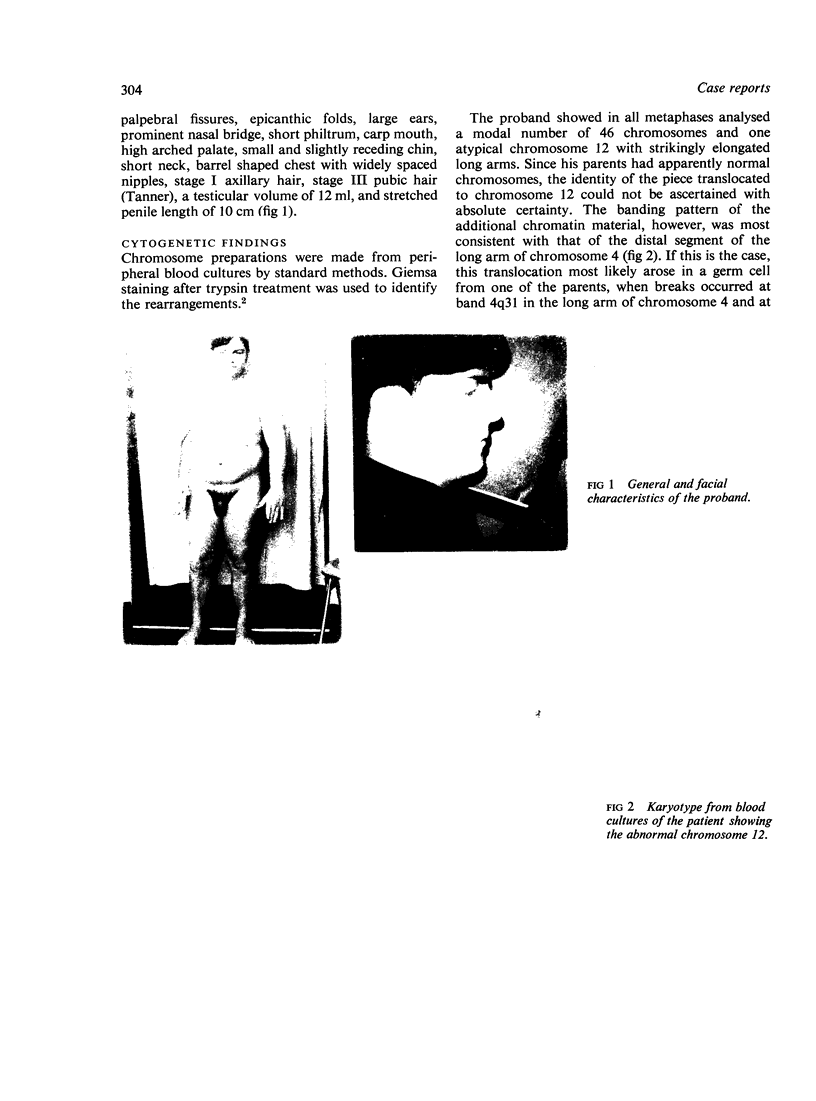
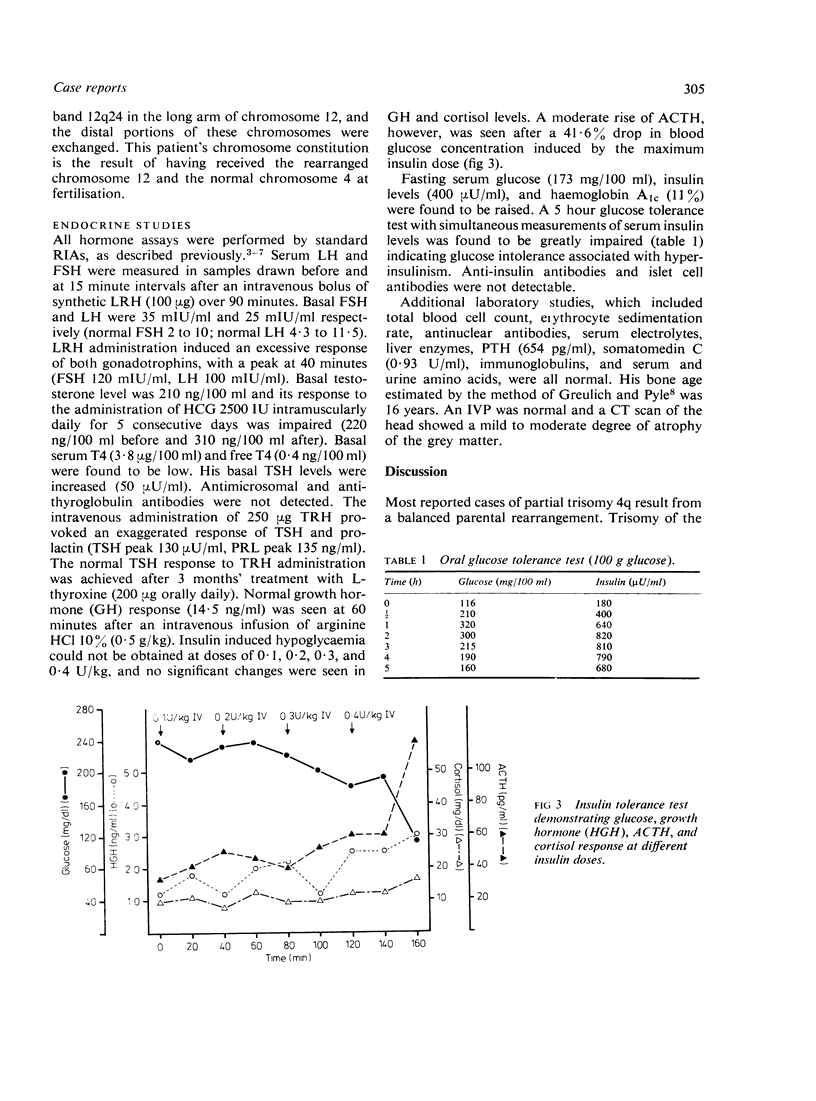
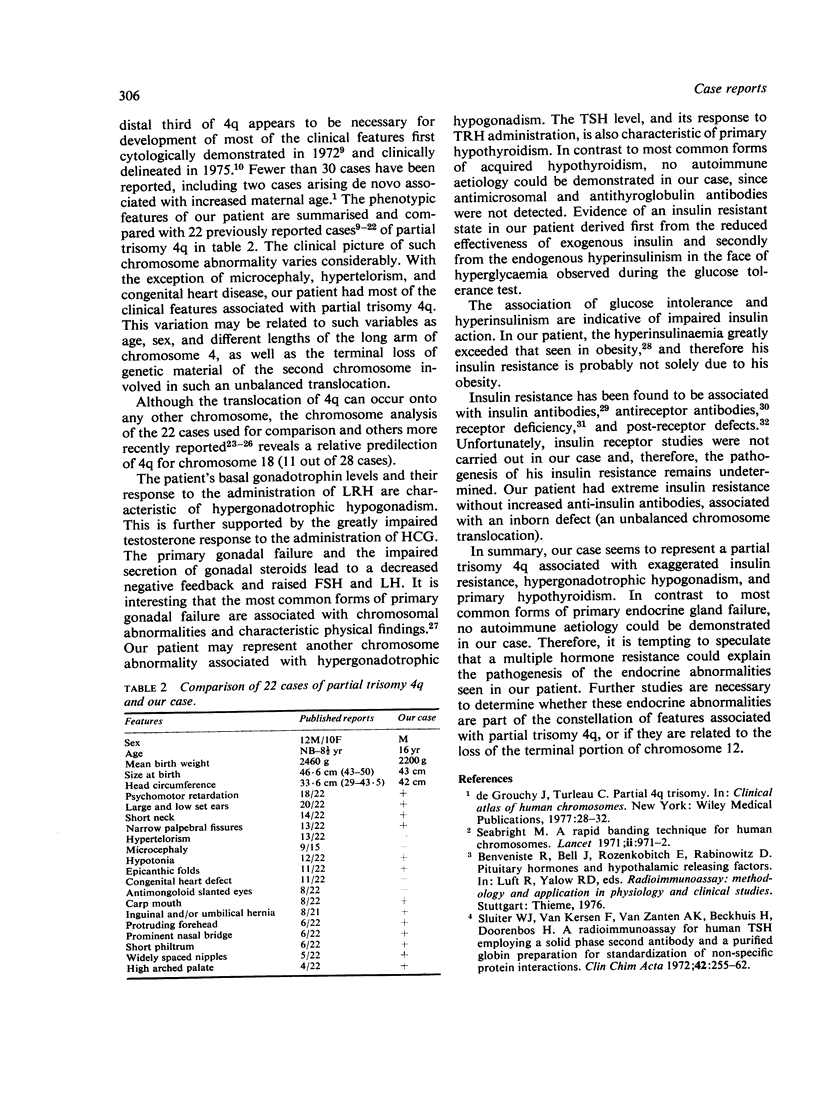
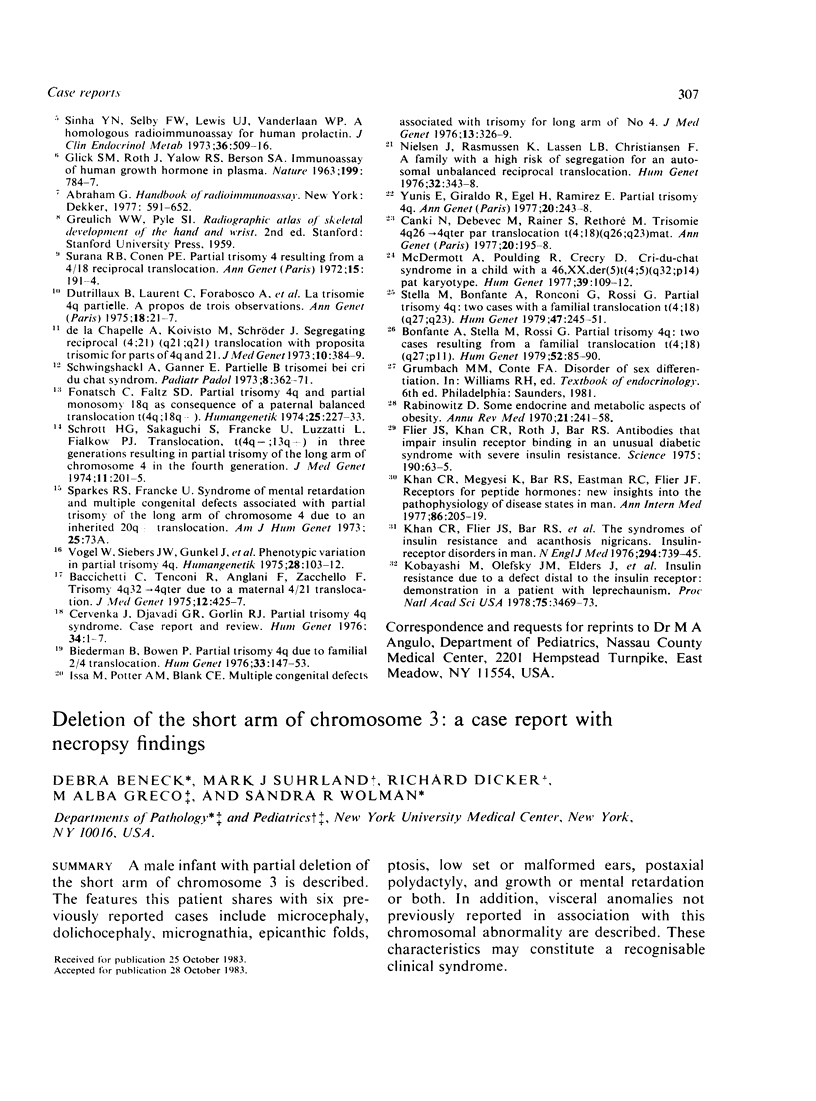
Images in this article
Selected References
These references are in PubMed. This may not be the complete list of references from this article.
- Baccichetti C., Tenconi R., Anglani F., Zacchello F. Trisomy 4q32 leads to 4qter due to a maternal 4/21 translocation. J Med Genet. 1975 Dec;12(4):425–427. doi: 10.1136/jmg.12.4.425. [DOI] [PMC free article] [PubMed] [Google Scholar]
- Biederman B., Bowen P. Partial trisomy 4q due to familial 2/4 translocation. Hum Genet. 1976 Jul 27;33(2):147–153. doi: 10.1007/BF00281888. [DOI] [PubMed] [Google Scholar]
- Bonfante A., Stella M., Rossi G. Partial trisomy 4q: two cases resulting from a familial translocation t(4;18)(q27;p11). Hum Genet. 1979 Nov 1;52(1):85–90. doi: 10.1007/BF00284601. [DOI] [PubMed] [Google Scholar]
- De la Chapelle A., Koivisto M., Schröder J. Segregating reciprocal (4;21) (q21;q21) translocation with proposita trisomic for parts of 4q and 21. J Med Genet. 1973 Dec;10(4):384–389. doi: 10.1136/jmg.10.4.384. [DOI] [PMC free article] [PubMed] [Google Scholar]
- Flier J. S., Kahn C. R., Roth J., Bar R. S. Antibodies that impair insulin receptor binding in an unusual diabetic syndrome with severe insulin resistance. Science. 1975 Oct 3;190(4209):63–65. doi: 10.1126/science.170678. [DOI] [PubMed] [Google Scholar]
- Fonatsch C., Flatz S. D. Partial trisomy 4q and partial monosomy 18q as a consequence of a paternal balanced translocation t(4qminus; 18qplus). Humangenetik. 1974;25(3):227–233. doi: 10.1007/BF00281431. [DOI] [PubMed] [Google Scholar]
- GLICK S. M., ROTH J., YALOW R. S., BERSON S. A. IMMUNOASSAY OF HUMAN GROWTH HORMONE IN PLASMA. Nature. 1963 Aug 24;199:784–787. doi: 10.1038/199784a0. [DOI] [PubMed] [Google Scholar]
- Kahn C. R., Flier J. S., Bar R. S., Archer J. A., Gorden P., Martin M. M., Roth J. The syndromes of insulin resistance and acanthosis nigricans. Insulin-receptor disorders in man. N Engl J Med. 1976 Apr 1;294(14):739–745. doi: 10.1056/NEJM197604012941401. [DOI] [PubMed] [Google Scholar]
- Kahn C. R., Megyesi K., Bar R. S., Eastman R. C., Flier J. S. Receptors for peptide hormones. New insights into the pathophysiology of disease states in man. Ann Intern Med. 1977 Feb;86(2):205–219. doi: 10.7326/0003-4819-86-2-205. [DOI] [PubMed] [Google Scholar]
- Kobayashi M., Olefsky J. M., Elders J., Mako M. E., Given B. D., Schedwie H. K., Fiser R. H., Hintz R. L., Horner J. A., Rubenstein A. H. Insulin resistance due to a defect distal to the insulin receptor: demonstration in a patient with leprechaunism. Proc Natl Acad Sci U S A. 1978 Jul;75(7):3469–3473. doi: 10.1073/pnas.75.7.3469. [DOI] [PMC free article] [PubMed] [Google Scholar]
- McDermott A., Poulding R., Creery D. Cri-Du-Chat syndrome in a child with a 46,XX,der(5),t(4;5)(q32;p14)pat Karyotype. Hum Genet. 1977 Nov 2;39(1):109–112. doi: 10.1007/BF00273159. [DOI] [PubMed] [Google Scholar]
- Nielsen J., Rasmussen K., Lassen L. B., Christansen F. A family with a high risk of segregation for an autosomal unbalanced reciprocal translocation. Hum Genet. 1976 Jun 29;32(3):343–348. doi: 10.1007/BF00295827. [DOI] [PubMed] [Google Scholar]
- Rabinowitz D. Some endocrine and metabolic aspects of obesity. Annu Rev Med. 1970;21:241–258. doi: 10.1146/annurev.me.21.020170.001325. [DOI] [PubMed] [Google Scholar]
- Schrott H. G., Sakaguchi S., Francke U., Luzzatti L., Fialkow P. J. Translocation, t(4qminus;13qplus), in three generations resulting in partial trisomy of the long arm of chromosome 4 in the fourth generation. J Med Genet. 1974 Jun;11(2):201–205. doi: 10.1136/jmg.11.2.201. [DOI] [PMC free article] [PubMed] [Google Scholar]
- Schwingshackl A., Ganner E. Partielle B-Trisomie bei Cri du Chat Syndrom. Padiatr Padol. 1973;8(4):362–371. [PubMed] [Google Scholar]
- Seabright M. A rapid banding technique for human chromosomes. Lancet. 1971 Oct 30;2(7731):971–972. doi: 10.1016/s0140-6736(71)90287-x. [DOI] [PubMed] [Google Scholar]
- Sinha Y. N., Selby F. W., Lewis U. J., VanderLaan W. P. A homologous radioimmunoassay for human prolactin. J Clin Endocrinol Metab. 1973 Mar;36(3):509–516. doi: 10.1210/jcem-36-3-509. [DOI] [PubMed] [Google Scholar]
- Stella M., Bonfante A., Ronconi G., Rossi G. Partial trisomy 4q: two cases with a familial translocation t(4;18)(q27;q23). Hum Genet. 1979 Apr 5;47(3):245–251. doi: 10.1007/BF00321016. [DOI] [PubMed] [Google Scholar]
- Surana R. B., Conen P. E. Partial trisomy 4 resulting from a 4-18 reciprocal translocation. Ann Genet. 1972 Sep;15(3):191–194. [PubMed] [Google Scholar]
- Vogel W., Siebers J. W., Gunkel J. Uneinheitlicher Phänotype bei Partialtrisomie 4q. Humangenetik. 1975 Jun 19;28(2):103–112. doi: 10.1007/BF00735742. [DOI] [PubMed] [Google Scholar]
- Yunis E., Giraldo A., Zuniga R., Egel H., Ramirez E. Partial trisomy 4q. Ann Genet. 1977 Dec;20(4):243–248. [PubMed] [Google Scholar]




